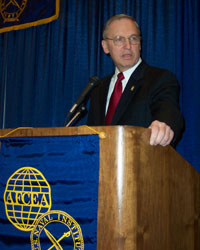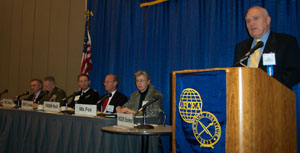Tuesday, February 1, 2005
Quote of the Day:
“There is no going back—transformation is here to stay.”
—Vice Adm. Arthur K. Cebrowski, USN (Ret.).
 |
Vice Adm. Arthur K. Cebrowski, USN (Ret.), outgoing director of the Office of Force Transformation, gives the kickoff address at West 2005. |
The day’s first speaker was Vice Adm. Arthur K. Cebrowski, USN (Ret.), the outgoing director of the Office of Force Transformation. One day after resigning his position, Adm. Cebrowski launched into an assessment of the ongoing force transformation and threw down the gauntlet for radical changes in the way the Defense Department shapes the military.
Saying that transformation is here to stay, Adm. Cebrowski offered the audience, “There is no going back … who wants to be less networked? Who wants to know less? Who wants to be slow and lethargic? Who wants to be ponderous and clumsy?”
However, to address the challenges of transformation, Adm. Cebrowski called for attendees to look at transformation through the lens of economics. Defense planners are still using old business models for planning, and the admiral called for “a whole new intellectualization” for transformation and force structure.
This new approach would scrap longtime—and even recently implemented—methodologies for designing and procuring systems. Using the U.S. Navy as a model, he called for changes that would permit the development of a scalable fleet. This would not take long, he offered, and a key would be the ability to create and preserve options. Instead of building one new lead ship and then conducting an analysis of it, the forced would be better served if three different contracting teams build three different ships that would be compared. This would avoid the trap of “data-free research” and would give the military the ability to create and preserve options, which is key to this new methodology.
The enemy is not waiting. It has moved off the traditional battlefield, he noted, and has decided not to bear the cost of confronting the U.S. military. Instead, it is moving into political and social domains to pass the cost to the United States. These social and political domains represent a new business model to which the United States must adjust. “The force must focus on winning the war and the peace, not just on waging combat,” Adm. Cebrowski declared.
Hot on the heels of Adm. Cebrowski’s address was the day’s first panel discussion, which focused on lessons learned in the Iraq War. Some of the panelists wasted no time in citing Adm. Cebrowski’s points—and in disagreeing with most of them.
 |
| Panelists discussing lessons learned in the Iraq War are (r to l) panel moderator Maj. Gen. Robert Scales, USA (Ret.); Christine Fox; Vice Adm. James Hull, USCG (Ret.); Cmdre. Peter Jones, RAN; Lt. Gen. James N. Mattis, USMC; and Ralph Peters. |
Panel moderator Maj. Gen. Robert Scales, USA (Ret.), coauthor of The Iraq War, said that the transformation is more than 10 years old, and it is time to hold it up and look at it. An observer can see the threads of continuity running from the present to the future, and the challenge is “the ability to reach into the chaff and pull out the wheat,” he stated. Today’s transformation is based on network-centric warfare, but that works better over the larger scale. In this war, the success of networks is on the local level in settings such as back-alley payoffs.
Lt. Gen. James N. Mattis, USMC, commanding general, Marine Corps Combat Development Command, agreed with Gen. Scales in that the United States’ very dominance of modern forms of warfighting has driven the enemy into historic forms of fighting that this country has not yet mastered. “Don’t patronize this enemy—they mean business,” he warned. “They mean everything they say.” Citing the need to diminish the conditions that provide recruits for the enemy, the general also was warfighter-blunt about the need to kill all of its forces. “You go into Afghanistan where guys slapped women around for five years simply for not wearing a veil—they have no manhood left. It’s fun to kill them.”
Christine Fox, president of the Center for Naval Analysis, compared processes in the 1990s with today’s environment. In the 1990s, the doctrine largely comprised an unwillingness to take risks and an unwillingness to risk civilian casualties. She called for force planners to engage a degree of risk, and a key to making that work is for tactics, doctrine and procurement to be decided at the tactical level.
Cmdre. Peter Jones, RAN, former commander of the interdiction force in the Iraq War, related how interoperability in the littoral environment involved maritime and land forces from several nations and different services. While network-centric tools were a big help, there is a need for officials to clearly articulate their philosophy of command.
Adm. James Hull, USCG (Ret.), former commander, Atlantic Area, noted that a new maritime force for the United States comprises the U.S. Navy, the U.S. Marine Corps and the U.S. Coast Guard. This force took part in operations in Iraqi waters, and participants learned much from their interoperation. One key lesson was the importance of small patrol boats, which the Navy is moving away from, and boarding teams for protecting key maritime and coastal assets.
Following those exchanges of conflicting ideas came the West 2005 keynote luncheon speaker, Adm. Vern Clark, USN, chief of naval operations. Adm. Clark offered a perspective on what the strategic environment will look like and how it will influence operations.
 |
| Adm. Vern Clark, USN, chief of naval operations, gives the keynote luncheon address at West 2005. |
Yet, the current fighting in Iraq probably is the most likely harbinger of future military operations. The military must design a force from the ground up that will optimize itself in this new challenge. “We can talk about transformation, but until we know our tasks and missions and types of conflicts, we won’t be able to determine what we need [so that we will] know what we really will build for,” he said.
After the year 2006, all new ships and boats will be never-before seen, he noted. Change is at hand. The characteristics that will allow the Navy to respond to its challenges will involve lethality, especially speed and agility, in packages different from today. Adm. Clark offered that it was foolish to put the force in large force sets that made it easy for an enemy to attack.
The admiral cited the need for a strong partnership between the military and industry as absolutely essential for building an effective future force. Large areas of the military will look at post-Iraq investments, he said, and now is the time for discussion.
—Scheduled for Wednesday at West 2005: Speeches by U.S Pacific Fleet Commander Adm. Walter F, Doran, USN, and Dr. Linton Wells II, acting assistant secretary of defense for networks and information integration and Defense Department chief information officer; along with panel discussions on ForceNet, defense acquisition and the Navy’s human capital strategy.




Comments